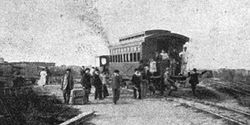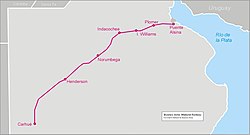Buenos Aires Midland Railway
| Buenos Aires Midland Railway | |||
|---|---|---|---|

A train in the Puente Alsina-Puente de la Noria section, 1908.
|
|||
| Overview | |||
| Native name | Ferrocarril Midland | ||
| Type | Regional rail | ||
| Status | Company defunct; Puente Alsina-Marinos del Crucero General Belgrano branch currently operated by Trenes Argentinos. | ||
| Locale | Buenos Aires Province | ||
| Termini |
Puente Alsina Carhué |
||
| Services | 1 | ||
| Operation | |||
| Opened | 1909 | ||
| Closed | 1948 (company) | ||
| Owner | Government of Argentina | ||
| Technical | |||
| Track length | 517 km (321 mi) | ||
| Track gauge | 1,000 mm (3 ft 3 3⁄8 in) | ||
|
|||
The Buenos Aires Midland Railway (BAM) was a British-owned railway company which operated in Argentina, where it was known as Ferrocarril Midland de Buenos Aires. The company built and operated the 1,000 mm (3 ft 3 3⁄8 in) gauge (metre gauge) line between Puente Alsina and Carhué in Buenos Aires Province.
In 1948, the railways of Argentina were nationalised, the BAM becoming part of Belgrano Sur Line; the company closed as a result. Nowadays, services on the line are operated by the state-owned company Trenes Argentinos, the concessionary of Puente Alsina-Marinos del Crucero General Belgrano branch.
In 1904, the Buenos Aires Province granted entrepreneur Enrique Lavalle a concession to build a metre gauge railway line between Puente Alsina and Carhué. The company and line were named "Buenos Aires Midland Railway", so the Lacroze Brothers registered the Spanish form "Ferrocarril Central de Buenos Aires". Works were led by ideologue Eduardo Casey, who had founded the city of Venado Tuerto some time before.
Construction of the line began in 1907, with works carried out by Argentine company Hume Hnos., hired by Lavalle. By November that year the line had extended to Puente de la Noria (now Ingeniero Budge station). The service was operated initially using a Koppel steam locomotive and a unique coach.
The BAM soon entered into conflict with the French-owned company, Ferrocarril Compañía General de Buenos Aires (CGBA), which was also building railways in the same part of the Province, a situation with potential to bankrupt both BAM and CGBA. The legal situation was also complicated: while National Law 2.793 gave priority to the company that had been granted concession first, BAM in this case, the concession granted to BAM had been given by a Province; therefore the CGBA also had rights to claim.
...
Wikipedia

